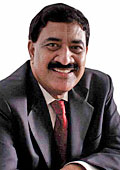 |
| The future looks good: HP's Managing
Director Balu Doraisamy |
Here's
a spot quiz, the answer to which may surprise you. Which is the
largest selling personal computer in India? The answer: Hewlett
Packard (HP). But, the company has been strangely reticent about
tom-tomming its success. "Yes, we have not been blowing our
trumpet about the significant success we have had in India. That's
because we would rather have our products, services, people and
customers speak for us," says Balu Doraisamy, Managing Director,
HP India.
Not many people are aware that HP's operations
in India generate revenues of Rs 12,250 crore and employ around
29,000 people. The company is the market leader in PCs, jousts
for the #1 spot with IBM and Sun Microsystems in the server market,
is the runaway leader in the printing and imaging segment, and
has emerged as a major player in the managed outsourcing contracts
space. Its software division, meanwhile, has increased revenues
10-fold in the last five years. Says Doraisamy: "We have
grown at a CAGR of 35 per cent over the last five years. For HP,
this is the fastest growing market worldwide."
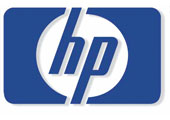 Succeeding
in the fiercely competitive Indian market has not been easy. The
key has been HP's strategy of providing the latest technology
at the right price points. "Unlike some of our competitors,
we don't offer end-of-life products here. We are aware that the
India is a value market and not one where price is the sole determinant
of choice," says Doraisamy. Succeeding
in the fiercely competitive Indian market has not been easy. The
key has been HP's strategy of providing the latest technology
at the right price points. "Unlike some of our competitors,
we don't offer end-of-life products here. We are aware that the
India is a value market and not one where price is the sole determinant
of choice," says Doraisamy.
HP has a 21 per cent share in the five million
units a year Indian PC market, which includes desktops and notebooks
(laptops). Ravi Swaminathan, VP, Personal Systems Group (PSG),
HP India, points out that the company had a mere 7 per cent share
in the desktop market just five years ago. "Today, that figure
has grown to 18 per cent," he says. HP's position in the
notebook market is much stronger-it commands a 39 per cent share
in the one million units a year market. "India is a value-conscious
market; buyers here consider the total cost of ownership rather
than the initial investment alone," he says. "Here,
our 350 service centres across the country give us an advantage
that few others can match." HP is now planning to capitalise
on its enormous lead in the notebook market to further consolidate
its position. Says Doraisamy: "Prices of notebooks are falling.
The day when there will be a notebook on every desk is not far
away."
The Four Ss
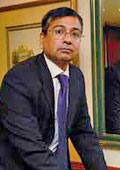 |
 |
"Our
350 service centres in India give us an advantage that few
thers can match"
Ravi Swaminathan
VP/Personal Systems Group |
"We want to
make greater inroads into the
fast-growing
Indian market"
Ajay Gupta
President/HP Labs |
Servers: For it hardware companies, the Indian
server market is a key area of attraction. According to IDC, the
Indian server market-traditionally Big Blue's turf-was estimated
at $583.16 million (Rs 2,624.22 crore then) in 2006. The market
has three distinct segments-the low-value, high-volume, entry-level
x86-based servers; the non-Intel Unix-based servers; and the high-end
server market comprising blade servers and mainframes. At the
top end and in the mid-market segment, HP competes fiercely for
market leadership with IBM and Sun Microsystems, but it has struggled
in market for entry-level servers. But Doraisamy says this is
part of a well thought out strategy. "HP has consciously
chosen to stay away from the lower end of the market. Our focus
is on profitable growth."
Software: HP is also very bullish about the
progress made by its software group. The sector is extremely profitable
and offers very high margins, and here HP's Open Call Media platform
has done well. Doraisamy points out that the software group's
revenues have grown 10-fold over the last five years. "There
is further scope for tremendous growth," he says.
Storage: In the Rs 706-crore storage market
(which includes Network Attached Storage and external controller-based
storage), HP is the third-largest player after IBM and EMC in
terms of value, and leads in terms of units and terabytes shipped.
This market is set to grow at 25 per cent and HP expects to derive
more revenues from it.
Services: The one segment where HP has not
done as well as its rivals is in the outsourced services space.
While competitors like IBM have bagged big-ticket deals like the
$750-million (Rs 3,075-crore), 10-year contract from Bharti Airtel
and the $620-million (Rs 2,542-crore) Idea deal, HP has won nothing
of note. Kapil Jain, VP, HP Services, however, denies this. "We
have had significant wins like the Bank of India and Bank of Baroda
deals," he says. Brave words, but the numbers show that HP
India derives a mere $150 million (Rs 615 crore), or 6 per cent
of its Indian revenues, from outsourced it services. Also, the
BOI and bob deals were considerably smaller than the Bharti Airtel
and Idea ones.
|
INTERVIEW:
BALU DORAISAMY/MANAGING DIRECTOR/HP
'India is HP's Fastest Growing Market'
|
|
 Balu
Doraisamy, 51, managing
Director of Hewlett Packard India, has grown the company
from Rs 420 crore in revenues eight years ago to India's
largest hardware player with revenues of Rs 12,250 crore.
Here, he discusses HP's operations in India, its competitors
and future plans with BT's Venkatesha
Babu. Excerpts: Balu
Doraisamy, 51, managing
Director of Hewlett Packard India, has grown the company
from Rs 420 crore in revenues eight years ago to India's
largest hardware player with revenues of Rs 12,250 crore.
Here, he discusses HP's operations in India, its competitors
and future plans with BT's Venkatesha
Babu. Excerpts:
HP India keeps a low profile. Why?
It's deliberate (laughs); we would rather
our products, services, people and customers speak for us.
We have been very visible in the marketplace, but probably
not in the media. In the last five years, HP India's revenues
have grown at a compounded annual growth rate of 35 per
cent.
HP is one of the few MNCs to have
successfully cracked the Indian market (even as others like
Dell have struggled). What do you know that others don't?
We read the pulse of the Indian market
correctly. Unlike some of our competitors, we don't introduce
end-of-life products here. We have the utmost respect for
the Indian customer and all our international products are
simultaneously launched here. That is one of the key reasons
for our success.
In the outsourced services segment,
you haven't had major wins like a Bharti Airtel or Idea
deal. Why?
I accept that we haven't had headline-grabbing
wins (like the ones mentioned above), but the perception
that this is a weak link is not true. We have also won large,
managed outsourcing deals from Bank of India and Bank of
Baroda. One has to remember that there have been very few
deals of the size of an Airtel or an Idea. But you will
hear shortly of some of significant wins (by us) in this
segment.
HP India accounts for just about
2 per cent of HP's global revenues. How important are the
Indian operations to HP?
India is the fastest growing market
for HP worldwide-it is growing faster than even China-though,
admittedly, on a smaller base. HP is committed to the Indian
market. (HP's global CEO) Mark (Hurd) has clearly signalled
that.
|
Unlike his colleague, though, Doraisamy is
candid about HP's failure to make a mark in this market. "Yes,
we did go head to head with IBM in the recent Idea deal and lost.
But one has to recognise that such large deals don't come by every
day. There are some significant deals in the pipeline and we should
hopefully be able to bag a few of them," he says, but declines
to elucidate further.
The Strongest Arrow
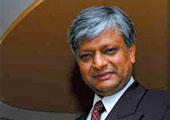 |
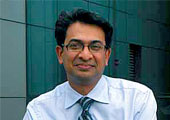 |
"We
have won significant deals from Bank of India and Bank of
Baroda"
Kapil Jain
VP/ HP Services |
"We are now the fourth-largest
computer systems vendor in India"
Rajan Anandan
VP/ Dell India |
The Imaging and Printing Group (IPG) is the
strongest arrow in HP's quiver and contributed nearly all of the
company's international profits till 2004. In India, HP has a
dominant 75 per cent market share in this segment. Ravi Aggarwal,
President, IPG, HP India, says the all-in-one's, also known as
multifunction devices (MFDs)-which combine the functions of a
printer, copier, fax and scanner-are the fastest growing product
in the company's portfolio. Leveraging its core strength in printers,
HP has been able to extend its lead in MFDs over rival products
from Xerox and Canon.
However, in the small office home office
(SOHO) segment, where inkjet printers still hold sway, Epson is
snapping at its heels. Says N. Samba Moorthy, Senior General Manager
(Sales and Marketing), Epson India: "Because we are #2, we
try harder." Dell, which had tried hard to muscle into this
market, however, has come a cropper and has failed to make any
inroads into the printer segment internationally and in India.
India a Resource Base
Increasingly, HP is targeting India not only
as a key market but as an important resource base to serve its
international customers. It is carrying out a substantial chunk
of application services, maintenance and development work out
of India for them. The scale may not yet match that of an IBM,
but Doraisamy says that HP is doing "some cutting edge work"
out of India. "Not many people remember that along with Texas
Instruments, HP was one of the first companies that identified
India's prowess in the IT arena and made substantial investments
here," he adds. Amitabh Ray, Director, IBM Global Services
India, however, points out that it is Big Blue, with more than
53,000 people, that has better leveraged Indian resources. "None
of our multinational competitors has been able to scale or execute
the kind of complex work we do here," he says.
|
DELL IN THE WELL
And why HP is smiling.
|
|
 There's
a new global market leader in PCs-Hewlett-Packard (HP).
The end of Dell's decade of dominance reveals limitations
of its direct selling model. The PC business has become
increasingly commoditised, and customers worldwide are looking
at factors beyond price-like service and support-where Dell
has failed to live up to expectations. There's
a new global market leader in PCs-Hewlett-Packard (HP).
The end of Dell's decade of dominance reveals limitations
of its direct selling model. The PC business has become
increasingly commoditised, and customers worldwide are looking
at factors beyond price-like service and support-where Dell
has failed to live up to expectations.
There has turbulence at the top, as
well. Founder Chairman Michael Dell, 42, was forced to sack
CEO Kevin Rollins in January 2007 and take up the reins
himself. Then, the Securities Exchange Commission (SEC),
the US market watchdog, is examining its books for possible
misdemeanours even as investigators probe its cozy past
relationship with Intel.
It has also failed quite spectacularly
in India. Rajan Anandan, Vice President, Dell India, admits
this, albeit indirectly. "We are now the fourth-largest
computer systems vendor in India," he says. Incidentally,
Michael Dell, on his recent visit to India, set his team
a target of doubling Dell India's turnover to $1 billion
(Rs 4,100 crore), but the company has not announced any
time frame to achieve this stiff target.
While Dell has lurched from one disaster
to another, HP, under the leadership of Mark Hurd, has quietly
consolidated its position as the world's leading technology
company, and even overtaken IBM in revenues. So, for the
moment at least, HP has every reason to smile.
|
But Zarir Batliwala, Head (HR), HP India,
says that one of the key attractions of HP in the job market is
that there are very few companies in the world that operate in
all the segments of it industry-like hardware, software and services.
"That is one of the reasons why HP's attrition rate, at 12
per cent, is well below the industry standard (18 per cent),"
he says.
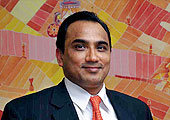 |
"There's
more value to be unlocked in the KPO market"
Sanjay Singh
President and CEO/HP BPO |
One reason for that could be the fact that
unlike most of its rivals, which have massive call centres and
BPO outfits in India, HP BPO, its business process outsourcing
arm, employs only 6,600 people in the country and focuses exclusively
on the non-voice, transaction processing market. "We deliberately
kept away from the low-value, low-margin voice business; industry
trends over the last couple of years have vindicated our stand,"
says Sanjay Singh, President and CEO, HP BPO. While rivals such
as IBM's Daksh and EDs's MphasiS have ramped up their India presence
inorganically, HP is unlikely to follow suit. "Since we don't
need a large voice presence, there are few interesting options
in the BPO market," says Singh, adding that HP BPO will shortly
open its second facility in Chennai.
Within the transaction processing business,
HP BPO focuses strongly on the finance and accounting (F&A)
vertical. Singh claims that HP BPO is among the largest F&A
outfits in the country, with over 5,000 people on its rolls. "There's
more value to be unlocked in the KPO market and we have a growing
team of over 600 specialists," says Singh, adding that he's
now looking at "cities such as Jaipur, Chandigarh and Coimbatore
to expand into".
 |
"Multifunction devices
(MFDs) are the fastest growing product in our portfolio"
Ravi Aggarwal
President/IPG |
New Products
HP is now focussing on launching new products
tailor-made for the Indian market. Says Ajay Gupta, President
of HP Labs, the R&D arm of the technology services giant:
"We started by focussing on what we could do to bridge the
digital divide. Now, we want to make greater inroads into the
fast-growing Indian market."
Despite being the market leader in PCs, for
example, HP's growth in this segment has been hamstrung by the
fact that conventional keyboards require users to have a functional
knowledge of the English alphabet. So, it developed the Gesture-based
keyboard that allows users to write in their native languages
(and save or transmit the image). This keyboard, HP is hoping,
will help drive the sales of its PCs in the Indian hinterland.
Good to Great
HP India's contribution to its parents' global
turnover is just about 2 per cent. Doraisamy, however, believes
that this is just the beginning. "HP is committed to India.
Good companies either grow revenues or cut costs, but great companies
do both. My aim is to make HP India a great company," he
says. it spends in India are expected to sprint along at about
three times the GDP growth rate; Doraisamy says his goal is to
grow HP India at 1.5 times the industry growth rate. That's a
tall target; and global CEO Mark Hurd, who led the company past
IBM as the world's largest tech company, will be watching Doraisamy
very carefully.
-additional reporting by
Kapil Bajaj
|






 Succeeding
in the fiercely competitive Indian market has not been easy. The
key has been HP's strategy of providing the latest technology
at the right price points. "Unlike some of our competitors,
we don't offer end-of-life products here. We are aware that the
India is a value market and not one where price is the sole determinant
of choice," says Doraisamy.
Succeeding
in the fiercely competitive Indian market has not been easy. The
key has been HP's strategy of providing the latest technology
at the right price points. "Unlike some of our competitors,
we don't offer end-of-life products here. We are aware that the
India is a value market and not one where price is the sole determinant
of choice," says Doraisamy. 

 B
B

 T
T
